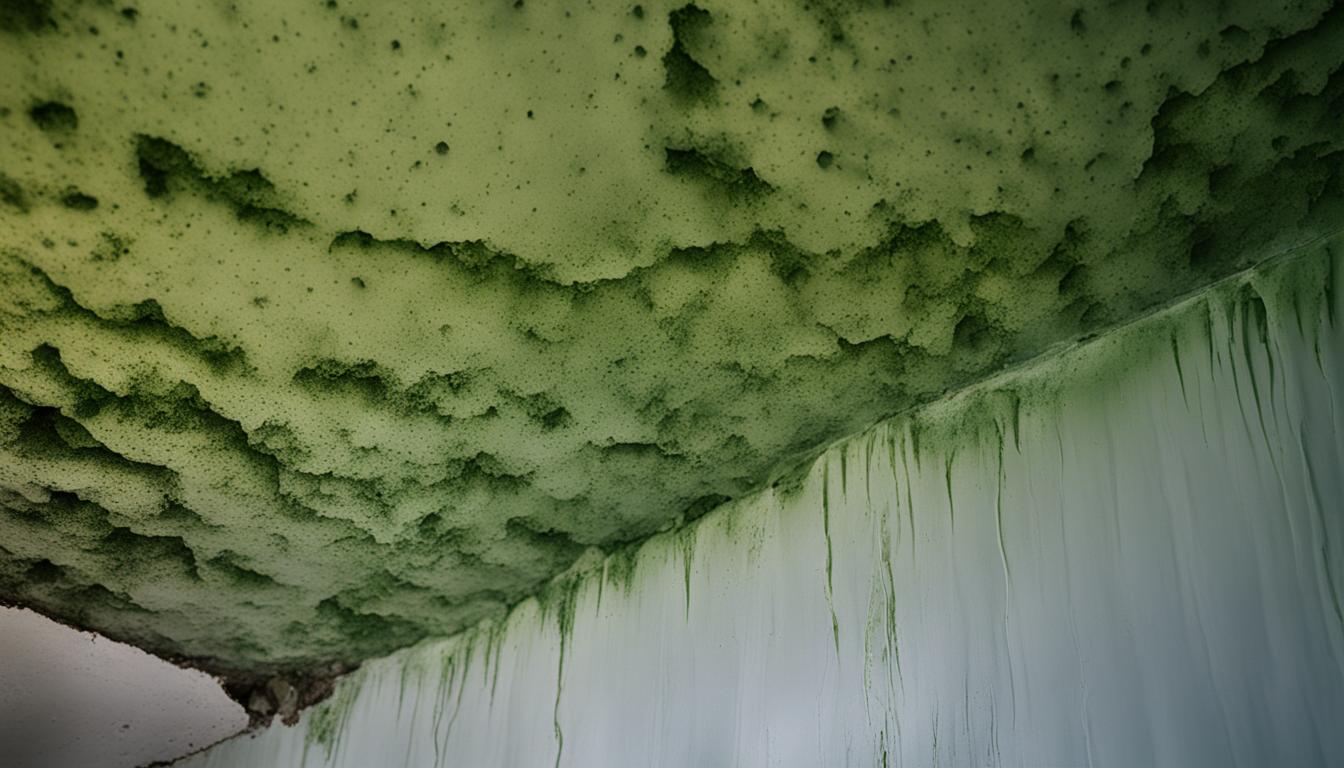If you are concerned about the air quality in your home, you may have considered the possibility of mold being present. Did you know that mold can grow in your walls, hidden from sight? Mold in walls can lead to serious health hazards and structural damage if left unchecked.
In this article, we will explain how mold grows in walls, the risks it poses to your health, and how to prevent its growth. We will also discuss the signs that indicate the mold is present and what to do if you discover it.
If you notice any of these signs, it is essential to take immediate action to prevent the mold from spreading. Ignoring the presence of mold can lead to serious health risks, including respiratory issues and allergic reactions. It can also cause structural damage to your property if left untreated.
Key Takeaways
- Mold inside walls can cause health hazards and structural damage if left unchecked.
- Preventative measures such as moisture control and proper ventilation can reduce the risk of mold growth in walls.
- Visible mold growth, musty odors, and water stains on walls are common signs of mold presence in walls.
- Professional mold remediation may be necessary to remove mold from walls effectively.
- Prompt attention to mold in walls is crucial for protecting your health and your property.
Understanding Mold Growth in Walls
Mold growth in walls can be a serious issue if left unaddressed, and it's important to understand how it starts in the first place. Mold spores are present everywhere, but they only grow in the presence of moisture. When there is moisture inside a wall, it creates an environment in which mold can thrive. Common sources of moisture include leaking pipes, condensation, and high levels of humidity. Not all wall materials are created equal when it comes to mold susceptibility. Organic materials such as drywall, wood, and wallpaper are more likely to provide nutrients to help mold grow compared to inorganic materials such as concrete and metal. This means that if you have walls made of organic materials, you need to be especially vigilant in preventing mold growth. Regular inspection of your walls for signs of moisture or water damage can help prevent mold growth before it starts. If you do discover mold, it's important to address it promptly to prevent it from spreading and causing further damage.Health Risks Associated with Mold in Walls
If mold is present in your walls, it can have a severe impact on your health. Breathing in mold spores can lead to respiratory issues such as asthma, coughing, and wheezing. Prolonged exposure to mold can also cause allergic reactions, including skin irritation, eye irritation, and nasal congestion. In some cases, mold exposure can even cause neurological symptoms such as memory loss and headaches. Children, elderly individuals, and people with weakened immune systems are particularly susceptible to the health effects of mold exposure. If you suspect that your walls have mold, it's essential to take immediate action to protect yourself and your loved ones. One way to prevent the health risks of mold exposure is to identify and fix the source of moisture that is causing mold growth. In some cases, it may be necessary to hire a professional to remove the mold thoroughly. A certified mold inspector can assess the extent of the mold infestation and recommend an effective remediation plan. Proper ventilation and moisture control can also help prevent mold growth from reoccurring in the future.Signs of Mold Presence in Walls
If mold is growing inside your walls, you may not notice it until it has spread and caused damage. However, there are tell-tale signs that can indicate the presence of mold in walls. Being able to recognize these signs is crucial in detecting mold early and preventing it from causing harm to your health and home. The following are some common signs of mold presence in walls:| Signs | Description |
|---|---|
| Visible Mold Growth | Mold on the surface of walls or inside walls may be visible in patches or spots, and can appear white, black, green, or gray. |
| Musty Odor | A musty or earthy smell could indicate the presence of mold growing inside your walls or other hidden spaces. |
| Water Stains on Walls | Water stains on walls could mean that there has been a previous water leak or moisture issue, creating a breeding ground for mold growth. |
Dealing with Mold in Walls: Remediation and Prevention
If you suspect mold growth inside your walls, it's crucial to take immediate action to prevent further damage and health issues. Here are some essential solutions to deal with mold in walls:Professional Assessment
The first step in dealing with mold in walls is to get a professional assessment. Certified mold inspectors can test your home for hidden mold growth and identify the source of moisture that facilitates its development. With proper testing and assessment, you can determine the extent of the damage and the best course of action to take.Mold Removal
Once you identify mold inside your walls, it's crucial to remove it professionally and promptly. DIY projects may cause further damage and lead to unnecessary expenses. Professional mold remediation experts use specialized equipment and techniques to remove mold safely and effectively, preventing its spread throughout your home.| Mold Removal Benefits | Dangers of DIY Mold Removal |
|---|---|
| Thorough and effective mold removal techniques | Further damage to the walls and health risks to individuals performing the task |
| Certified and trained professionals using specialized tools and equipment | Spread of mold spores throughout the property, leading to more significant expenses |
| Peace of mind and a healthier home environment | Limitations in masking off, cleaning, and disposing of contaminated materials properly |
Moisture Control
Preventing moisture build-up inside your walls is vital in reducing the risk of mold growth. Ensure proper ventilation in bathrooms and kitchens, repair any leaks in pipes and faucets, and use dehumidifiers to keep humidity levels below 60%. Proper moisture control can help stop mold growth in its tracks and provide long-term benefits for your home's structural integrity and your family's health.Ventilation
Proper ventilation can help increase airflow and reduce moisture levels inside your home, which can prevent mold from growing in the first place. Make sure your home's heating, ventilation, and air conditioning systems are properly maintained and that the air filters are changed regularly to ensure proper air circulation. In summary, the best way to deal with mold in walls is to prevent it from growing in the first place. However, if you do identify mold growth inside your walls, seek professional assessment and removal services immediately. Additionally, maintain proper moisture levels and ventilation to reduce the risk of mold growth in your home.Hiring Professionals for Mold Cleanup
If you've found mold in your walls, it's crucial to take immediate action to prevent health risks and property damage. Professional mold remediation services can provide the expertise and equipment necessary to effectively remove mold from your walls and mitigate the risk of future growth. By hiring certified mold inspectors, you can ensure a thorough assessment of the mold issue and a comprehensive plan for remediation. Professionals have access to specialized equipment and techniques to safely and effectively remove the mold without causing further damage. Attempting to remove mold on your own can often lead to incomplete removal or even spread the mold further. Additionally, certain types of mold can be hazardous to your health and require specialized cleaning procedures. Investing in professional mold remediation can save you money in the long run by preventing further damage to your property and mitigating health risks. Don't take chances with your health and property - entrust the job to certified professionals.Conclusion
Now that you have a better understanding of the risks associated with mold inside walls, it's crucial to take action to prevent its growth and remove any existing mold. Remember to keep an eye out for the common signs of mold presence such as visible mold growth, a musty odor, and water stains on walls. Dealing with mold in walls requires a comprehensive approach that includes professional assessment, mold removal techniques, and preventive measures like moisture control and proper ventilation. Don't hesitate to hire certified mold inspectors and professional mold remediation services to ensure a thorough and effective cleanup process. By addressing mold in walls promptly, you can protect the health of individuals living in the home and the structural integrity of the property. Stay vigilant and take action at the first signs of mold presence to maintain a safe living environment.FAQ
What are the risks of having mold inside walls?
Mold inside walls can pose various risks to health. It can cause respiratory issues, allergic reactions, and other health effects when exposed to individuals living in the affected environment.
How does mold grow inside walls?
Mold can start growing inside walls when there is excessive moisture or a water source present. The moisture can come from leaks, condensation, or high humidity levels within the wall cavities.
Are there certain wall materials that are more susceptible to mold growth?
Yes, certain wall materials are more prone to mold infestation. Materials such as drywall, wallpaper, and wood paneling provide ideal conditions for mold growth due to their porous nature.
What are some common health risks associated with mold in walls?
Exposure to mold in walls can lead to respiratory issues such as coughing, wheezing, and difficulty breathing. It can also trigger allergic reactions, including sneezing, itching, and skin rashes.
What are the signs that indicate the presence of mold in walls?
Common signs of mold presence in walls include visible mold growth, a musty odor, and water stains on walls. If you notice any of these signs, it is important to address the issue promptly to prevent further damage.
How can I deal with mold in walls?
Dealing with mold in walls involves a two-step process: remediation and prevention. Professional assessment and mold removal techniques are necessary to effectively eliminate the mold. Additionally, implementing moisture control measures and ensuring proper ventilation can help prevent future mold growth.
Why should I hire professionals for mold cleanup?
Hiring professionals for mold cleanup offers several benefits. Certified mold inspectors have the expertise to accurately assess the extent of the mold problem and recommend the appropriate remediation actions. They can ensure a thorough and effective cleanup process, minimizing the risk of recurrence.





